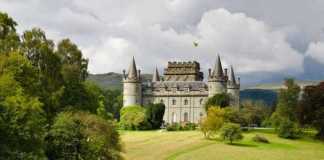Poland is a country that holds a special place in my heart, as my father was Polish, and I spent many happy summers there when I was a child. What is Poland known for? It is a beautiful country, with mountain ranges, forests, castles, and exciting cities filled with culture and history. Poland is a very religious country, with pilgrimage sites and a predominately Roman Catholic population. It produced one of the most popular popes in history, Pope John Paul II, as well as a whole array of well-known scientists, poets, actors, and musicians including Chopin, Marie Curie, and Copernicus. The country is steeped in tradition and culture and family is significant to the people of Poland.
However, there is a lot of sadness in Poland’s past. It has been occupied by various countries over the years, the last being the Soviet Union. During this time, the Trade Union, Solidarity, was formed and eventually, Poland gained independence. Poland also houses the notorious death camp, Auschwitz, where over one million Jews were killed during WWII. Without further ado, let’s look at the top 15 things Poland is known for. Hopefully, this will arouse your interest in the country, and you will want to visit. You won’t be disappointed.
Contents
What Is Poland Known For?
1- Auschwitz-Birkenau
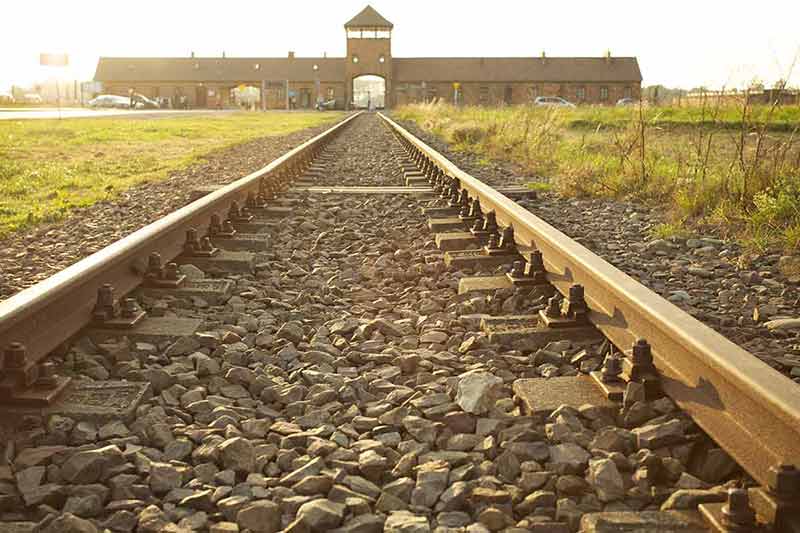
Auschwitz-Birkenau is a reminder of how inhumane people can be.
It is a symbol of the Holocaust when around six million Jews were murdered in various concentration camps in Germany and German-occupied countries, one of which was Poland.
Auschwitz was the largest of the concentration camps.
Auschwitz-Birkenau is still standing and can be visited.
In 2019, over two million people toured the site to remember a piece of history that should never be forgotten.
Auschwitz has an eerie, quiet feel about it, and it has been said that birds don’t sing there.
On the tour, you are taken to bare dormitories, the gas chambers, the parade grounds, and Block 11, where prisoners were executed against a brick wall.
In the rooms, there are black-and-white photos of past prisoners, which you could spend hours looking at.
Their faces are blank, and there is not a flicker of hope to be seen.
At Birkenau, part of Auschwitz, around 20,000 people were gassed each day and then burned.
The nearby residents said that they could smell the smoke all the time.
Recommended tour: From Krakow: Auschwitz-Birkenau Guided Tour
2- Pope John Paul II
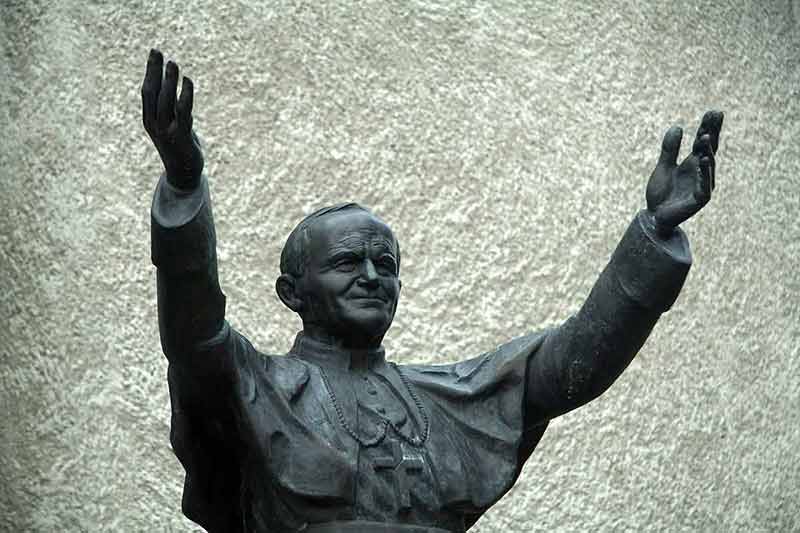
Pope John Paul II was one of the most loved popes in history.
I have friends who aren’t at all religious, who admired him and he is one of the most important people that came from Poland.
Pope John Paul II was born Karol Jozef Wojtyla in 1920 and was elected Pop in 1978.
He dabbled in acting as a young man before deciding on a life devoted to God and service to the people.
He made history by visiting more countries than any Pope before him, going to more than 100 countries during his papacy.
I remember well when he visited the UK in the summer of 1982, the first visit by a Pope to the UK, a Protestant country.
The Pope was not only concerned with religion.
This made him stand out, as it is rare for Popes to get involved in other matters.
He was passionate about defending Poland against Soviet control and was a supporter of Solidarity.
He wanted Poland to be a country ruled by Poles, for the country to be a democracy again, and for everyone to have freedom of speech.
Pope John Paul II impacted the world with his writings on suffering, love, and death, as well as his endless advocacy for human rights, justice, and peace in the world.
He died in 2005, and a record six million people went to Vatican City for his funeral.
Pope John Paul II was so revered in Poland that a feast day was created to honour his life and achievements held on October 22nd each year.
Recommended tour: From Krakow: In the Footsteps of John Paul II Guided Tour
3- Solidarity

Most people have heard of Solidarity, the Polish movement against Communism and Soviet rule.
It began in 1980 at the Lenin Shipyard in Gdansk, in northern Poland.
The workers there formed a trade union, which was unheard of in a Communist state.
It led to strikes all over the country, and then martial law was imposed, which lasted from 1981 to 1983.
In 1989, however, Poland became an independent country, and Lech Walesa, the leader of Solidarity, played a big role in this process.
He became the first elected prime minister of Poland for 63 years, with Solidarity playing a big part in the transition from communism to capitalism.
Solidarity is an example of how countries can overturn oppression and live in freedom and democracy.
It should give hope to countries that are now living in a dictatorship.
Recommended tour: Gdansk: Private Communism Tour with Solidarity Center Museum
4- Polish Vodka
Polish vodka has an excellent reputation the world over and is a drink enjoyed at any get-together in Poland.
Perhaps it’s because of my Polish blood that I enjoy vodka!
Vodka originated in Eastern Europe in the early 15th century and was originally used for medicinal purposes.
However, people soon got a taste for it, and it was refined.
Now, Polish vodka is smooth and of high quality made from either fermented grain or potatoes.
It is usually drunk very cold in a chilled shot glass, unlike in many countries where vodka is drunk with a mixer such as tonic water or coke.
One of the top brands of Polish vodka is Sobieski, named after the 17th-century king, Jan III Sobieski.
It is made from rye grain and is one of the smoothest vodkas in the world.
Zubrowka is an interesting herb-flavoured vodka that has a piece of bison grass placed in it, with vanilla, coconut and almond flavours.
Other brands include Wyborowa and Luksusowa.
Nowadays, flavoured vodkas are also produced, such as lemon, strawberry, vanilla, and orange.
Poland also makes vodka with mead or honey.
Recommended tour: Warsaw: Polish Vodka Museum Tour with Tasting
5- Polish Food
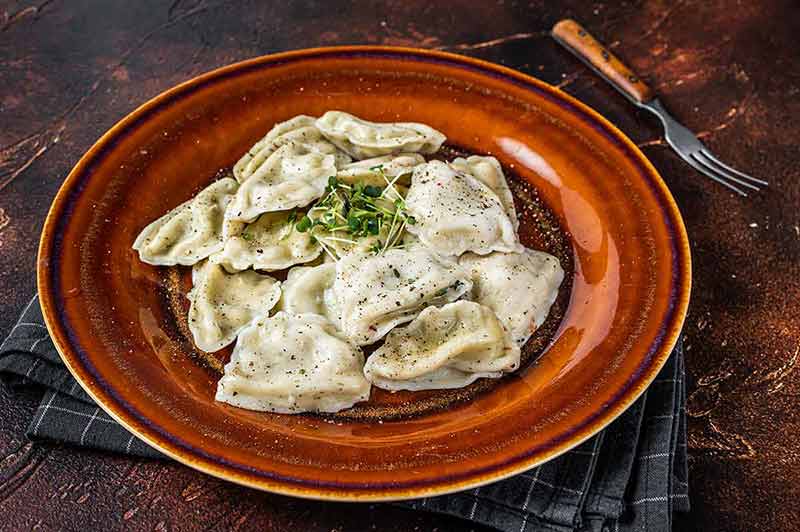
Polish food is not just potatoes, as many people seem to think.
There is much more to it than that, and you can get some delicious dishes.
Pierogi are part of Polish culture and are believed to have been eaten since mediaeval times.
They are dumplings that can be filled with such things as mushrooms, meat, cheese, potatoes, or sauerkraut.
They are often served with sour cream, onions, or even both and if you have a sweet tooth, you can get sweet pierogi with berry fillings.
The Poles generally like meat, and kielbasa is one of their favourite sausages made from pork, beef, or both and is either smoked, boiled, or grilled.
It has been part of Polish food culture for many centuries, and it is often served with pierogi.
Other savoury dishes include bigos, a stew made with meat, sauerkraut, and mushrooms.
Galabki, which are stuffed cabbage rolls, potato dumplings, and red cabbage, are also popular.
I remember that when I was in Poland, we used to have red cabbage with almost every meal!
When it comes to cheese, oscypek is very much favoured, but it is an acquired taste.
It is made from unpasteurized sheep’s milk, but the unusual thing is that the sheep they use are only from the Tatra Mountains in the south of the country.
It is heavily salted and smoked using aromatic mountain wood and is only made by an expert mountain shepherd or baca.
When it comes to sweet treats, babka is a traditional cake that has been made for centuries and is usually served on special occasions, especially around Easter.
It is made from sweet yeast dough and is baked in a bundt pan, which is a pan with a hole in the middle usually flavoured with orange or lemon, as well as cinnamon and sometimes raisins.
Recommended tours:
6- The Tatra Mountains
The Tatra Mountains are in the south of the country, at the border with Slovakia.
They cover more than 200 square km (72 square miles), with part of them in Poland and part in Slovakia.
Both Slovakia and Poland have a separate national park there.
The highest peak on the Polish side is Rysy and is 2,499 metres (8,199 feet) high.
The mountains are beautiful, especially in the winter when they are covered with snow.
You will also come across glacial lakes, the largest of which is Morskie Oro.
It is an amazing hike to the lake and takes about two hours.
It is uphill, but the road is asphalt, and you are rewarded with magnificent views at the top.
There are more than 170 hiking trails in the national park, and in the winter, you can ski.
There are many ski resorts in the area, including Zakopane, which is a beautiful town with picturesque views.
There is plenty of wildlife to be spotted in the Tatra Mountains National Park, including brown bears, marmots, the Eurasian lynx, red deer, roe deer, and wild boar.
Birds include golden eagles, black storks, and white-throated dippers.
Recommended tour: From Krakow: Day Tour of Zakopane and Tatra Mountains
7- Salt Mines
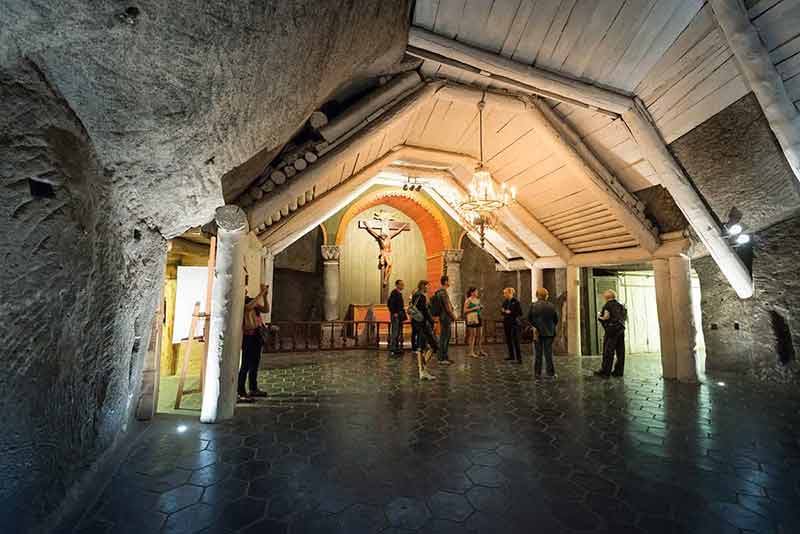
Poland has many salt mines, the most famous being Wieliczka, located in the metropolitan area of Krakow.
It is one of the world’s oldest salt mines and was first excavated in the 13th century.
It continued in operation until 1996, when it closed due to mine flooding and a drop in salt prices.
It is now a UNESCO World Heritage Site that can be visited by members of the public.
The mine is 327 metres (1,072.83 feet) deep and has passages stretching a massive 286.46 km (178 miles).
Be warned that you have to use the stairs, not the elevator, so it may be a little tiring coming back up but it is worth it.
You will see sculptures carved from salt, and there is even a salt chapel.
In addition, there are some interactive displays and sections that tell you about salt mining.
It is cool in the salt mines, usually staying around 14C (57F) throughout the year, so you do need to take a jumper, even in the summer.
It is also advisable to wear comfortable shoes.
Recommended tour: Krakow: Wieliczka Salt Mine Guided Tour
8- Krakow
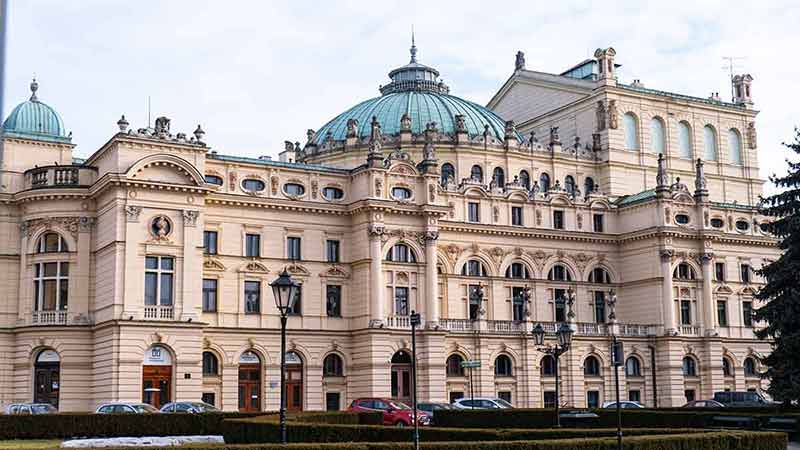
Krakow is in southern Poland on the banks of the River Vistula and is the place where people usually stay if they are going to visit Auschwitz.
However, there is much more to the city as Krakow is steeped in history and culture and has many museums, art galleries, and universities.
It is also the home of the 16th-century Wawel Castle, a UNESCO World Heritage Site.
There is a beautiful cobblestoned old town, filled with little cafes and interesting shops, and surrounded by mediaeval walls.
Museums in the city include the Galicia Jewish Museum, the Museum of Contemporary Art, and the Historical Museum of the City of Krakow.
If you are looking to party, Krakow will suit you down to the ground as there are clubs and bars all over the city, and the old town boasts that it has more venues per square metre than anywhere else in the world.
Kazimierz is another area that is good for nightlife, but it is less raucous than the old town.
You are more likely to find intimate cocktail bars here than rowdy nightclubs.
Recommended tour: Krakow: Wawel Castle and Cathedral Guided Tour
9- Bialowieza Forest
Bialowieza Forest is a UNESCO World Heritage Site and is one of the last ancient forests that used to stretch throughout Europe.
It lies on the border between Belarus and Poland in the northeast of the country.
Because it has been protected, it has survived in its natural state with some of the trees around 350 years old.
As well as the forest, it hosts a range of non-forest habitats, such as wetlands, wet meadows, and river valleys.
Bialowieza Forest supports complete food chains, and you will find large carnivores such as wolves, wild boar, and lynx, as well as smaller mammals such as hedgehogs, moles, red squirrels, and shrews.
The most spectacular animal is, however, the bison and there are over 900 free-roaming bison in the park, which makes up almost 25% of the bison population worldwide.
The Nature and Forest Museum in the forest will tell you all why the forest has been important to Poland over the centuries.
Recommended tour: From Warsaw: Small-Group Tour to Bialowieza National Park
10- Frederick Chopin
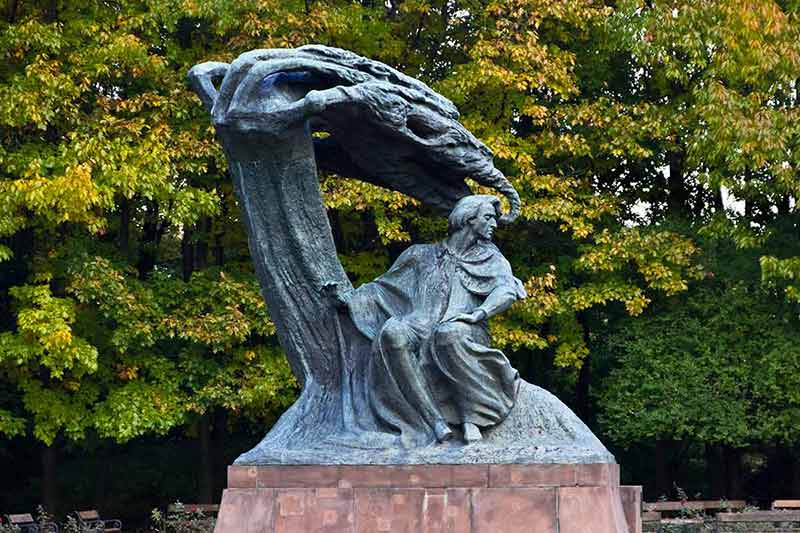
One of the greatest composers in the world was Frederic Chopin, a native of Poland.
He was born in 1810, and, as well as being a composer, he was a famous pianist.
He was considered to be revolutionary because he only wrote for the piano and used peasant dances for inspiration.
Chopin composed waltzes, mazurkas, nocturnes, polonaises, scherzi, and more, just for the piano at a time when orchestras were common.
However, he did also write two pieces for piano concertos while his larger-scale works include Fantasie in F Minor and Barcarolle in F Major.
Chopin’s works were all influenced by his native country, and he, in turn, influenced other composers such as Liszt, Rachmaninoff, and Gershwin.
Recommended tour: Warsaw: Private Life and Times of Frederic Chopin Tour
11- Częstochowa
Częstochowa, a city in central Poland, is an important pilgrimage site and the most visited in the country.
It has, on average, 4.5 million visitors a year.
I went there when I was 10, and I can still remember the crowds.
The main attraction is the Jasna Gora Monastery, dedicated to the Virgin Mary, and housing an iconic painting called ‘The Black Madonna of Czestochowa’, which is supposed to have miraculous powers.
It is painted on a wooden panel, and legend has it that it was painted by Luke the Evangelist, the author of the Gospel according to Luke in the first century AD.
However, scholars believe that it was painted later than this.
It was brought to Czestochowa in 1382 from Russia.
The painting is revered by the Polish people to the extent that it is unofficially called ‘The Queen of Poland’.
It is so important to them that it has even been taken out of the country during times of war to keep it safe.
Recommended tour: From Krakow: Full-Day Wadowice & Czestochowa Tour
12- Castles
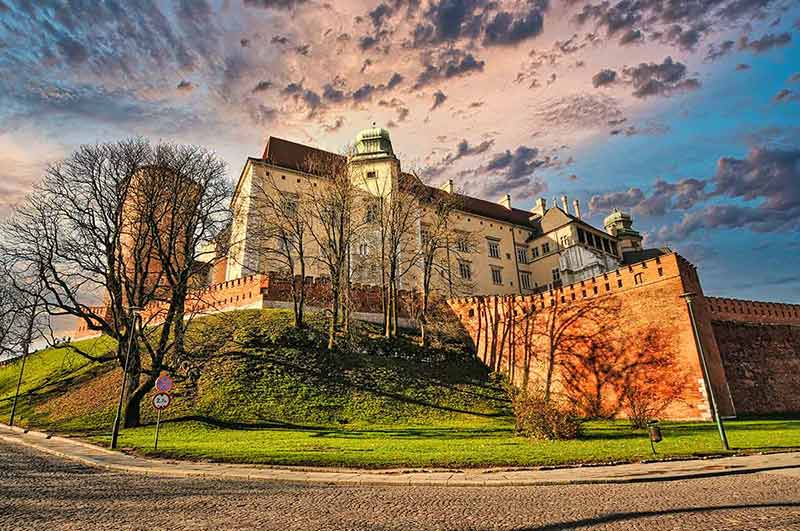
Poland has over 500 castles, many of which you can visit and, in some cases, stay overnight.
Castles are part of Poland’s cultural heritage, and many of them date to the Middle Ages.
One of these mediaeval castles is the Teutonic Castle in Malbork, which was built by the Teutonic Order, a Catholic religious institution, in 1274.
It is one of the largest castles in Europe and is a UNESCO World Heritage Site.
When it comes to land area, it is the largest castle in the world, with grounds covering 21 hectares (52 acres).
The castle is a prime example of Gothic architecture.
It has three separate castles, the High Castle, the Middle Castle, and the Outer Bailey, with many towers, and high walls.
You can take a tour of the castle, as well as explore the gardens and the chapels.
The castle houses artefacts, including over 2000 exhibits of amber.
Amber is found in Poland, and as early as the Neolithic period, people were using it to carve objects and jewellery.
Another important castle in Poland is Wawel Castle in Krakow, which used to be the seat of Polish kings.
Now it is an art museum housing paintings, sculptures, textiles, furniture and more in ten permanent exhibitions depicting royal life in the 16th, 17th, and 18th centuries.
Ogrodzieniec Castle in Silesia is considered to be one of the best-preserved mediaeval fortresses in Europe.
It has been used in many films and TV series, including The Witcher.
Moszna Castle in Opole Voivodeship is popular because it has 99 towers, and the architecture is stunning and elaborate.
Recommended tour: Recommended tour: Gdansk: Malbork Castle Regular Tour
13- The Mazurka
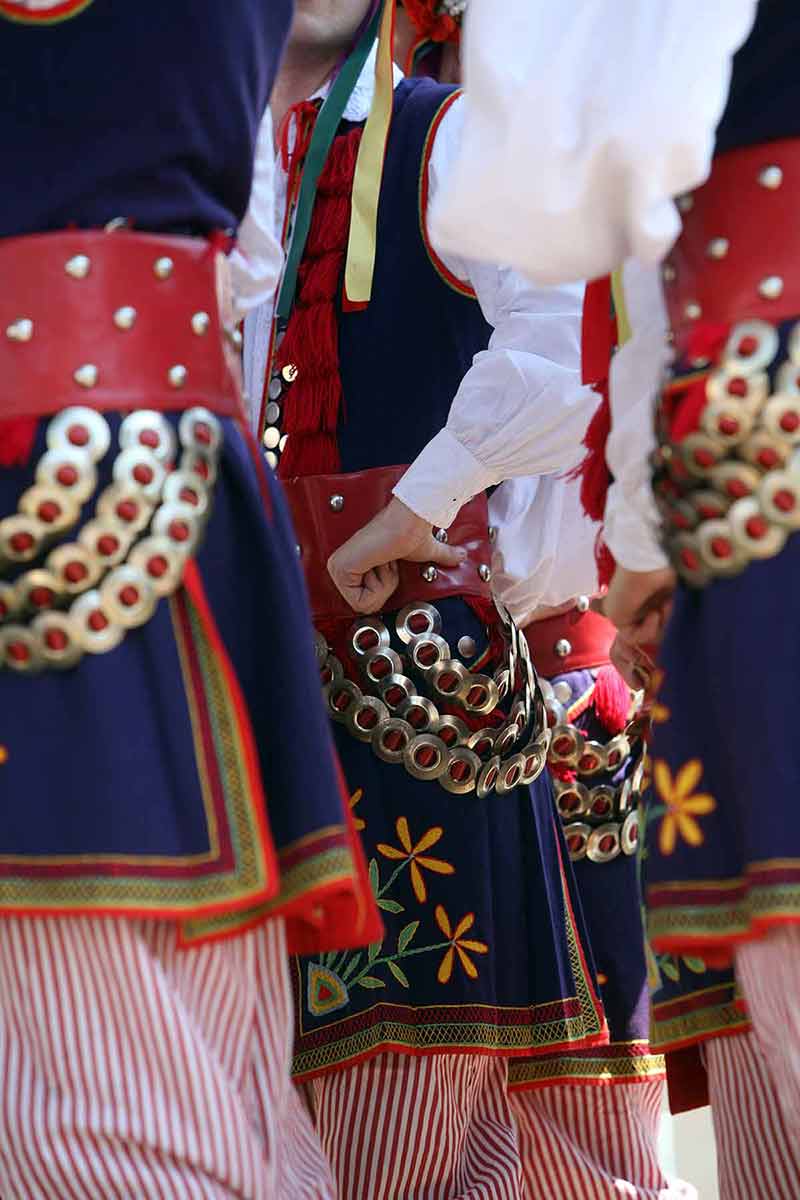
There are several traditional Polish dances, of which the Mazurka is one of the most popular.
It evolved during the 16th century in the countryside, but by the 19th century, it had made its way to court.
Chopin began composing piano mazurkas in 1824 and continued until he died in 1849.
However, he did make some changes, making the dance more technically interesting.
The traditional dance is characterised by its lively tempo and quick steps.
The footwork is complicated, with feet being stomped and heels clicked.
Strong accents are placed on the second or third beat and traditional Polish folk songs are used for the music.
In Chopin’s mazurkas, the dancers move with more grace, but the dance is still fast.
The allure of the Mazurka spread to other countries and was incorporated into other dances.
In Poland, the mazurka is danced mainly at special occasions such as weddings, concerts, and cultural festivals.
Recommended tour: From Krakow: Polish Folk Show with All-You-Can-Eat Dinner
14- Marie Curie
Despite the obstacles confronting her as a woman in what was then a man’s world, Marie Curie persevered in her desire to become a physicist and chemist.
She is known for her work in radioactivity and her discovery that radium could kill cancer cells.
Marie Curie was born in Warsaw in 1867 and studied there before moving to France, where she married Pierre Curie, a physicist whom she worked alongside.
They both received a Nobel Prize in physics in 1903.
Marie was the first woman to receive a Nobel Prize and the only woman to receive two Nobel prizes.
In 1911, she received the Nobel Prize in chemistry.
In 1906, Marie Curie became the first woman to become a professor at the University of Paris.
During WWI, Marie discovered that X-rays could help doctors find shrapnel and bullets in soldiers so that they could remove them.
She also developed mobile X-ray units so that they could be used in ambulances out in the battlegrounds.
The Polish people are proud of Marie Curie, and there is a museum in Warsaw dedicated to her life.
In 2011, during the International Year of Chemistry, Poland declared it the Year of Marie Curie.
15- A Very Complicated Language
Poland is one of the most difficult languages to learn, especially for English speakers.
For a start, the grammar is difficult and there are seven cases in Polish, whereas most other languages only have four.
The four are nominative, accusative, dative and genitive.
Poland adds on instrumental, locative and vocative.
Polish also has three genders: masculine, feminine and neuter.
Feminine nouns usually end in a neuter in o, and everything else is masculine.
Polish is also very difficult to pronounce.
There are a lot of clusters of consonants, even up to five consonants in a row.
Letters such as sz, dz, s, and z are common, and it takes a while to master the differences between them.
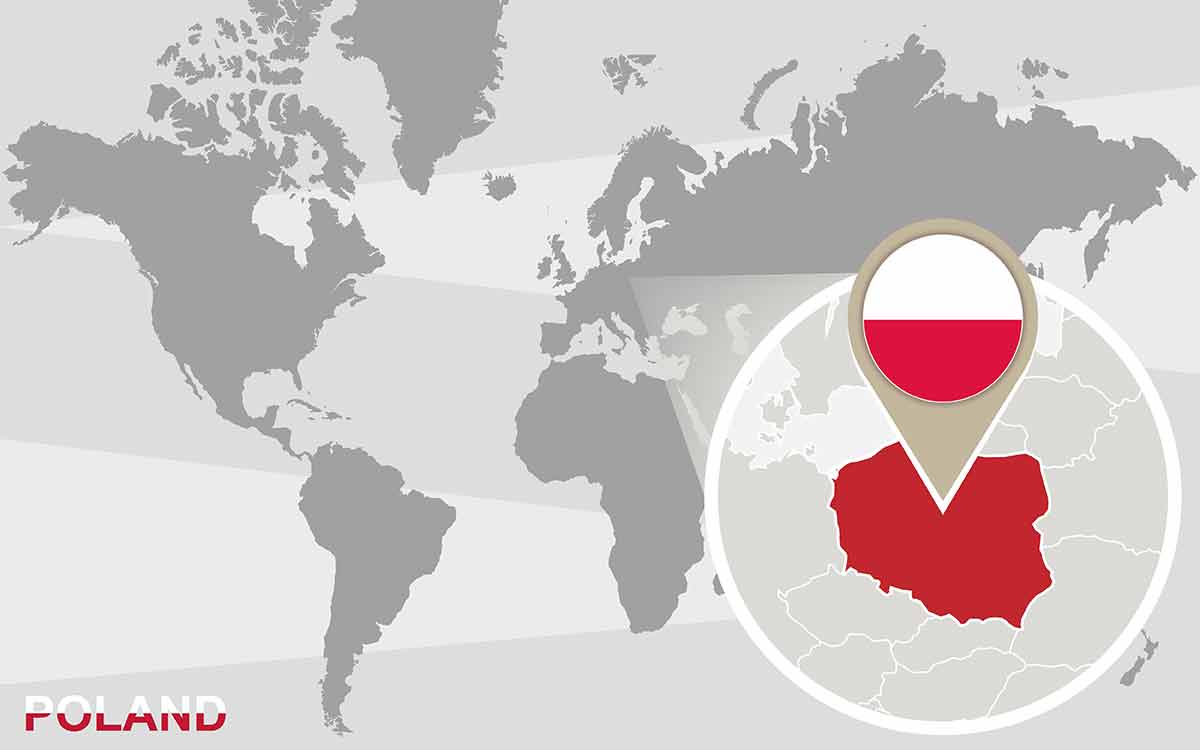
You may also be interested in:
- What is Turkey known for?
- What is Portugal known for?
- What is Greece known for?
- What is France known for?
- What is Belgium known for?
- What is Switzerland known for?
- What is Poland known for?
- What is Australia known for?
- What is Mexico known for?
- What is Germany known for?
- What is Croatia known for?
- What is Hungary known for?
- What Is Romania known for?
- What is The Netherlands known for?
- What is Scotland known for?
- What is Canada known for?
- What is Japan known for?
- What is China known for?
- What is Singapore known for?
- What is Vietnam known for?
- What is Thailand known for?
- What is Cuba known for?
- What is Argentina known for?
- What is Colombia known for?
- What is Spain known for?
- What is Italy known for?
- What is Ireland known for?
- What is Oregon known for?
- What is Colorado known for?
- What is Tennessee known for?
- What is Hawaii known for?
- What is Alabama known for?
- What is Illinois known for?
- What is Mississippi known for?
- What is Nevada known for?
- What is Maine known for?
- What is Idaho known for?
- What is Delaware known for?
- What is Maryland known for?
- What is Wisconsin known for?
- What is Miami known for?
- What is Virginia known for?
- What is West Virginia known for?
- What is Massachusetts known for?
- What is Boston known for?
- What is Florida known for?
- What is Kentucky known for?
- What is Indiana known for?
- What is Montana known for?
- What is Nebraska known for?
- What is Pennsylvania known for?
- What is Vermont known for?
- What is Arizona known for?
- What is California known for?
- What is South Carolina known for?
- What is North Carolina known for?
- What is Texas known for?
- What is Michigan known for?
- What is Ohio known for?
- What is Louisiana known for?
- What is Oklahoma known for?
- What is New York known for?
- What is Georgia known for?
- What is Utah known for?
- What is Connecticut known for?
- What is Rhode Island known for?
- What is Iowa known for?
- What Is Minnesota known for?
- What is New Hampshire known for?
- What is Arkansas known for?
- What is New Jersey known for?
- What is Missouri known for?
- What is North Dakota known for?
- What is South Dakota known for?
- What is Wyoming known for?
- What is Alaska known for?
- What is Washington known for?
- What is Seattle known for?
- What is New Mexico known for?
- What is Kansas known for?
- What is San Francisco known for?
- What is Chicago known for?
- What is Denmark known for?
- What is Norway known for?
- What is Sweden known for?
Plan Your Trip

Rent A Car – Find the best car rental rates at Discover Cars. They compare car hire companies to provide you with the best deal right now.

Find A Hotel – If you’re curious about this article and are looking for somewhere to stay, take a look at these amazing hotels.
